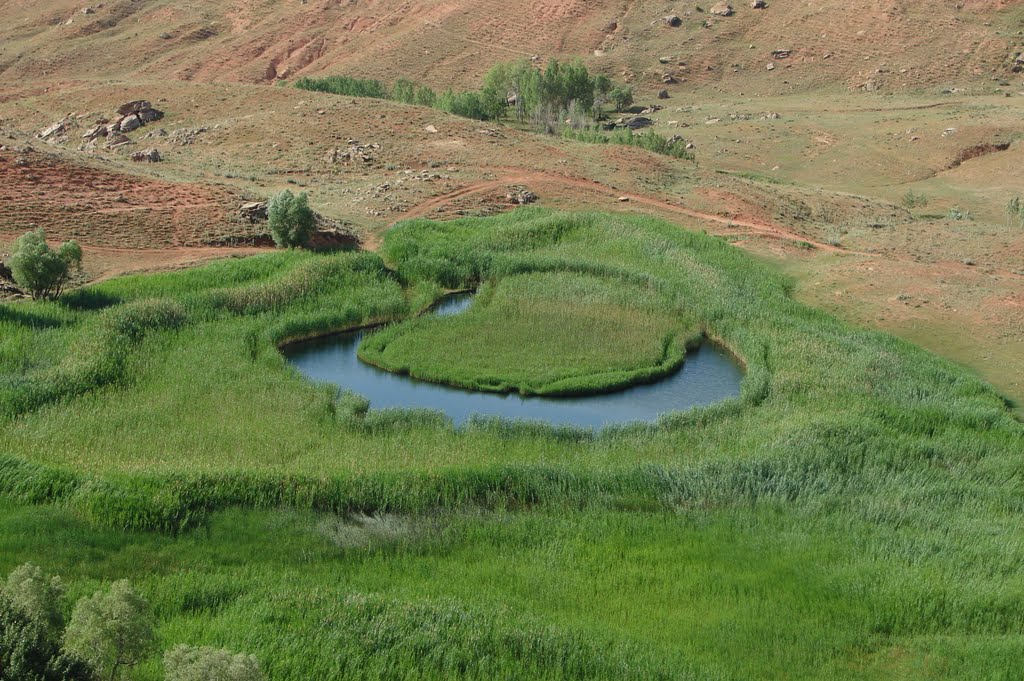Situated in Badrloo village, 15 km from Takab in West Azerbaijan Province, Chamli Gul catches the eyes of any traveler with its mysterious movements.
In Azeri language, Chamli Gul means an island with green lawn on a wetland. The name comes from the natural characteristic of the place; a large area of reeds and their interwoven roots which keep them afloat on the water surface, without touching the ground underneath.
This makes it appear that an over 100 sq.m. of greenery is like a moving island floating in different directions along with the water current or a breeze of air, creating a unique image.
The pond, on which the lawn floats, is located in a deep valley with reed beds, tall trees, green plains, and beautiful flowers. Its depth is estimated at about 8 to 15 meters and it is the natural habitat of beautiful wild geese.
No definite scientific explanation has been found for the unique characteristic of this floating meadow. Some experts attribute it to “Earth’s rotation and some others consider natural elements at play such as the wind, as the reason”, said the provincial head of Iran Cultural Heritage, Handicrafts, and Tourism Organization (ICHHTO) in West Azerbaijan, Amir Matloubi, speaking with Mehr News Agency.
Whatever the reason, Chamli Gul, also known as the floating island or “moving meadow”, enjoys a unique spectacular flora/vegetation and remains green even in the winter cold.
Unique Attractions
Lack of good roads, resting facilities, and sanitation appropriate to the needs of domestic and foreign tourists as well as insufficient publicity to introduce the place to tourists are among the main reasons that Chamli Gul has failed to attract as many visitors as its potentials, said Matloubi.
He further added that Takab has various unique tourist attractions, such as Arbaban Castle (or: Sardar Afshar Castle), Jam’e mosque of Takab, and Chamli Gul, but they have been overshadowed by the fame of Takht-e Soleiman, on of the most important and visited site.
Takht-e Soleyman (literally “the Throne of Solomon”, in ancient times known as Shiz or Adur Gushnasp, meaning “the Fire of the Warrior Kings”) is an archaeological site in West Azarbaijan. It lies midway between Urumia and Hamadan, very near the present-day town of Takab, and 400 km west of Tehran.
In spite of all shortcomings, about 5000 domestic and 200 foreign tourists visit the moving meadow annually.
Most visitors of Chamli Gul are locals from Takab, southern cities of West Azerbaijan, and from Zanjan, Kurdistan, and East Azerbaijan provinces, who choose to visit mostly in the spring.
Matloubi complains that since Chamli Gul is not a historical site, no attempt has been made by the provincial ICHHTO to inscribe it on the national heritage list. Some years ago, West Azerbaijan’s Department of Environment made efforts to inscribe it on the world heritage list but failed to take follow up action.
According to research and studies, the area belongs to the Tertiary geological period.
There are two ways to reach Chamli Gul: one is through the road from Takab to Badrloo, passing Yalghun Aghaj village and the second passes Hampa road to Badrloo, just before Ghusheh Balagh village.


